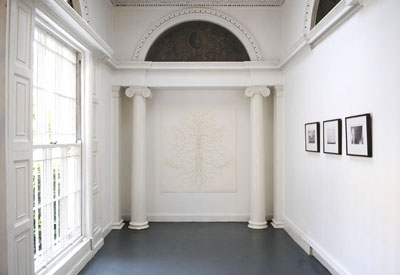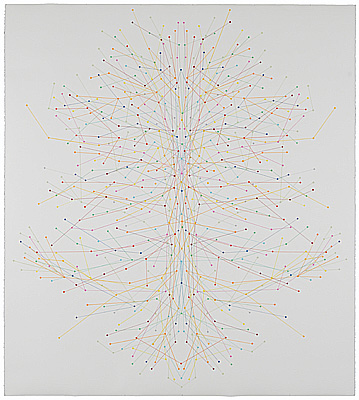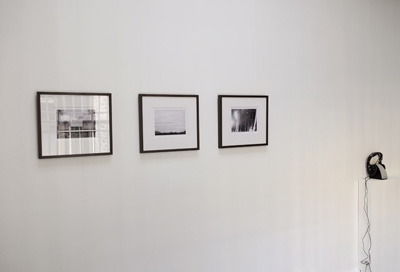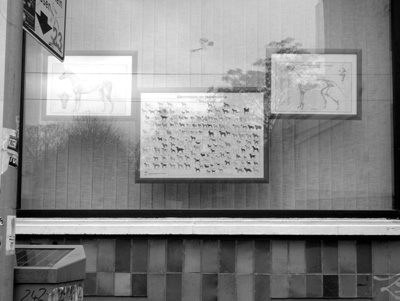The artist Ronnie Hughes’ recent exhibition Background noise at the Goethe Institute, Dublin, was curated by Mark Garry and is the focus of this conversation.
HM: Can you talk me through your thinking behind this exhibition? I noticed quite a bit of scientific referencing within the work.
RH: I am interested in science but, as in my other work, my intention is not to illustrate scientific theory (Goethe’s or anyone else’s) but to use the context to invoke an appearance of science – a simulacrum, if you will. The plan was to create a tension between the large work and the small, between exactitude and chaos, between the real and the imagined – between art and science. The hope was to create an experience that convinces, or seduces, the viewer into what essentially is a reflexive dialogue with the unquantifiable.
HM: Though quite scientific, the elements within Background noise were difficult to reconcile. I felt each piece was quite disparate and autonomous. As such it is somewhat difficult to reduce and allocate meaning to the work as a whole, placing it in some way in opposition to scientific methodology, which is often very reductive.
RH: I generally feel that while art can often appear reductive, it is generally more likely, and more important, for art to be expansive – to allow many possibilities of meaning, reaction and interpretation. In Background noise I deliberately combined three very divergent elements (the large drawing, the photographs and the sound pieces). These differences of pitch, allied to the context of the space, were what created the show’s particular energy. My hope was that each component part would influence how one thought about, or experienced, the others.
HM: Can you talk me through the large central drawing, Totem?
RH: Totem is a large drawing which occupies the back wall (between two neo-classical Doric columns) of the small gallery space. It is made up of hundreds of small colour particles that coalesce into an arrangement that was initially derived from a variety of natural forms (both flora and fauna). A succession of these forms was drawn then mirrored along a central vertical axis. The drawing developed organically and then at a certain point I began to connect the dots with lines that were also mirrored along the central axis. My idea was to mimic the symmetry found within nature but also to generate something colder, more artificial. There is also a flayed specimen factor to the work, as if an animal were being dissected and left open to viewing.
HM: Of course I do remember from biology lessons, there was always the need to pin down the dual parts of the animal in order to properly observe its internal systems. It’s a rather brutal non-emotive way of viewing a body. I have to say when I look at the pattern in Totem I see a tree, but I guess we all bring our own internal images to such a pattern. I also noticed a digitised printout look to it, each dot joining in a computer-like manner.
RH: Absolutely – the ‘tree’ is unquestionably there but the pattern also alludes to various dendritic forms found not only throughout the body but in any number of technological systems too.
HM: How was the work influenced by the research of Goethe? I can see that the work exposes a certain morphological identity.
RH: My interest in Goethe is primarily in three aspects of his (natural) scientific output: Firstly, his largely discredited work on colour theory. His vast body of work in this area had generally been derided, particularly in relation to his nemesis, Newton. Secondly, his studies in plant morphology, and thirdly his discovery and subsequent proof that the intermaxillary bone was peculiar to all mammals. These latter two are related in his demonstration that archetypal biological forms generate extensions of themselves to grow or develop more complex systems. His work directly influenced Darwin’s principles of evolution and as such it underscores much modern thought in numerous fields. I called the piece Totem in order to invoke the idea of the mystical, in that a certain aspect of nature worship is present.
HM: When I think of totems I think of familial lineage imbued within a pattern. Totems often have images of the ancestral suits on either side, the bear or the snake; each generation of the family adds another layer to the pole. They worship nature, but also their genetics.
RH: That element certainly appears and there is a charting relationship seen in the dots that make up Totem. The dots developed organically, but at the end I joined the dots with a brutally straight line.
HM: Yes, the genealogical tree seems rather cold, the only relationship between you and your ancestors is a straight line. A relationship should be shown with more complexity.
RH: It is quite modernist, that idea, the straight masculine line. It smarts of fascism and one thinks immediately of eugenics. The form seen in Totem may represent a simplified way of looking at an individual’s background and relationships. Such a chart imposes a strict order on something extremely complex.
HM: How does the sketch tie in with the three black-and-white photos?
RH: The second element in the exhibition is a small series of three B+W photographs. The first of these shows a dog genealogy chart in a Berlin window. The second shows a series of birds on an electricity line, seen from behind glass with random dirt-marks and an out-of-focus fly. The third is a difficult-to-read shot of painted stars on a circus roof tent. Together these works allude to tensions between fate and accident, order and entropy, between the teleological and the merely random.
HM: The photograph Line stood out in my mind; I thought it was a photograph of a painting, it almost looked unreal.
RH: Line is a photograph of birds sitting on a wire. It was an image that simply caught my eye; however for me when I look at it I immediately see lines of music, the birds appear as if musical notes. One can also think of a Morse code that needs to be deciphered. There seemed to be a precision about their arrangement. Why it looks somewhat unreal is that it was taken through a window; the glass had changes in its depth due to age and was grimy. The fly on the windowpane I think brings to mind entropy, the idea of decay and death.
HM: Totem and the set of black-and-white photographs for me stood definitely apart, and because of that I found it hard to reconcile the entire work, it played on my mind. Yet because of this the entire work remained with me. The third element within Background noise is a set of musical pieces. They say in the catalogue that the tracks are sourced?
RH: Well, they’re not music at all, though in some way they are musical. The third element is a series of six sound pieces that are scientifically collected samples of radio waves from a variety of astronomical sources including remnant blackbody radiation from the Big Bang (though this is contested), radio waves from a collapsed star, and cosmic debris from our own atmosphere. These radio waves are converted to sound waves to make them audible and the results feel strangely like a hybrid of composed electronic music and sounds from nature (waves crashing, wind, birdsong). The similarity of these truly alien sounds to more familiar earthly forms highlights the possibility of generative structures which underscore everything in the universe, or then again maybe the fact that they have been ‘mediated’ to make them audible simply makes them seem to appear in recognisable forms. It’s the rumination on this question that interests me.
HM: When I first entered the exhibition I saw a visual system to it. When we see something the eye naturally separates the distinct aspect to the image into colour, form, line, etc. I saw this in the show, with the colour-filled Totem, beside it the black-and-white forms and finally, the output from the object. Does this again point to Goethe’s colour theory?
RH: In opposition to Newton’s classic theory-oriented approach, Goethe used ‘exploratory experimentation’ – a more hands-on approach that, as an artist, I find more intuitively satisfying. Trial and error. Make, do and see. It, unlike Newton’s wheel, worked in practice: It included magenta, formed complementary oppositions and allowed for greys. Finally and importantly, Goethe’s colour theory stressed that all colour was experiential and relative.
HM: How did you find working with fellow artist Mark Garry in a curatorial manner?
RH: Mark rather usefully encouraged me from the outset to go slightly left field from my typical practice of drawing and painting. He was great to bounce ideas off and his experience of working with sound (and sound equipment!) was invaluable.
Ronnie Hughes is currently showing new drawings at Sebastian Fath Contemporary, Mannheim, Germany. He is represented by Rubicon Gallery, Dublin.
Hilary Murray





